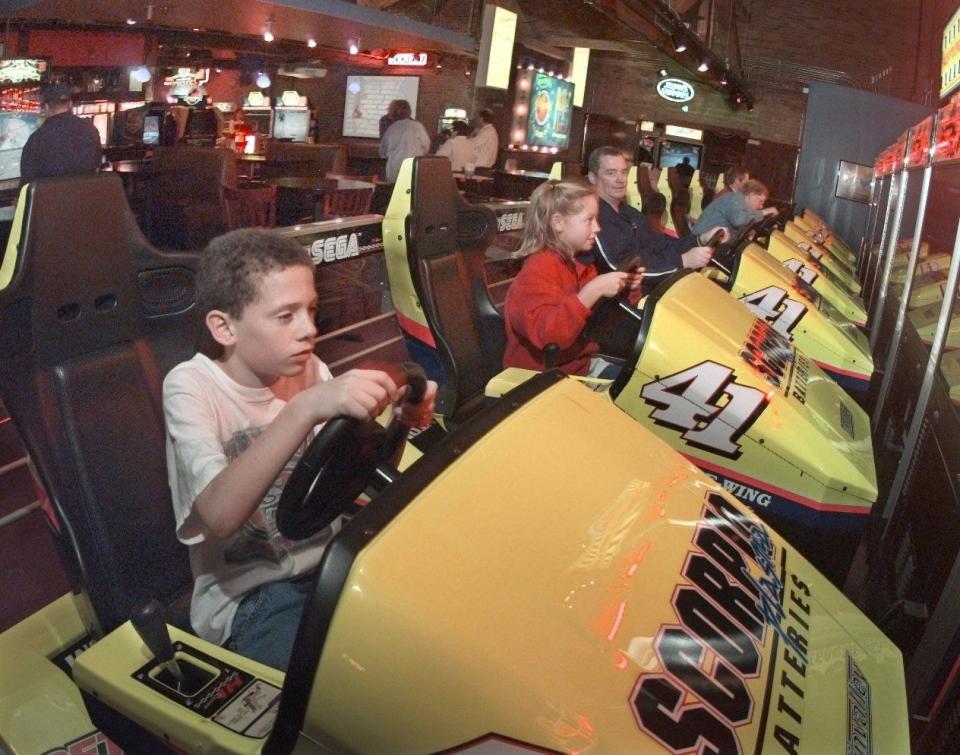Jillian’s was a night spot that helped energize Rochester’s High Falls entertainment district and helped usher in a concept locally known as “Eatertainment.”
The huge club, at 61 Commercial St., mixed dining and drinking with bowling, billiards, a “video café” and a dance floor called the Love Shack. The place was part of a smallish chain, and Rochester’s Jillian’s was the second to open in New York state.
The club sponsored concerts at the High Falls festival site and hosted events like a first-of-its-kind post-prom party. And in a refreshing change, Jillian’s was the largest business to open without public funding in the heavily subsidized High Falls area.
Jillian’s originated in 1988 with its first club in Boston. The Rochester version came in 1999, opening in a century-old former Trolley Barn where street trolleys from the era went for repairs. A Jillian’s in the Albany area squeaked in just before Rochester’s as the first statewide.
Jillian’s: What is ‘eatertainment?’
The “eatertainment” idea was explained in news stories as combining entertainment options with drinks and food under one roof.
“Jillian’s has become the Wegmans of the genre, a one-stop-shopping fun experience,” wrote Frank Bilovsky in a 1999 Democrat and Chronicle story.
There was certainly a lot of space for in the 45,000-square-foot, two-story complex. There was also a lot of excitement among both patrons and politicians. The High Falls district, conceived in the 1980s, had struggled to gain traction for years despite an influx in city investments that eventually topped $30 million. Empire Brewing Co. helped kick-start the district when it debuted in 1997, and officials were equally optimistic about Jillian’s.
“I think (it’s) going to be an instant hit,” then-Mayor William A. Johnson Jr. said in a news story.
Jillian’s sees early success
He was right. Jillian’s reportedly took in more than $1 million in its first six months and its success led to talk of opening a second Jillian’s in the Rochester area.
Especially popular with younger club-goers, Jillian’s was a nerve-jangling spectacle of sights and sounds. Former Democrat and Chronicle music critic Jeff Spevak described the place as “like Chuck E. Cheese with pool sticks.”
Of the 15-lane bowling area, which incorporated glow-in-the-dark lighting, fog machines and pulsating music, Spevak wrote, “Screens over the pins flit between images of the Three Stooges and Jamiroquai videos with leather-clad bondage babes, as if a channel-surfing caffeine addict held the remote.”

The crowds kept coming, at least for a while. More private development followed in High Falls.
After the High Falls festival site opened, Jillian’s promoted a concert there with 3 Doors Down, Oleander and Seven Mary Three. After the Rochester Rhinos won the A-League championship in 2000 at nearby Frontier Field, fans celebrated with a post-game party at Jillian’s.
The post-prom party, held in 2002 for Wilson Magnet High School, was said to be the first of its kind sponsored by Wilson or any Rochester City School District high school.
The end for Jillian’s in Rochester
A casting call for the ABC reality show The Bachelor was held at Jillian’s in 2004. That same year, problems began to arise.
“No single issue led to Jillian’s closing, but rather a collection of burdens,” Richard Mullins wrote in a Democrat and Chronicle story. “The economy was not flourishing in Rochester…and Eastman Kodak Co., Xerox Corp. and others largely stopped booking corporate parties.” The club was too big, officials said, and the largely commercial district itself didn’t attract “stroll-in” traffic that Jillian’s experienced at its other locations. (Empire Brewing experienced similar difficulties before closing in 2003.)
The Jillian’s site remained secured by padlocks and chains for months. Plans of bringing another bowling-and-billiards operator there were floated but never materialized. In 2006, a new country-western-themed entertainment complex called Saddle Ridge moved in, a five-in-one complex that included four other bars. The venture lasted only a few months before closing later that year.
Meanwhile, city officials shifted gears with High Falls. What began as a historic district before switching to an entertainment district was transformed into an “urban village,” where people live and work.
Housing was added and firms moved in. The former Jillian’s is now home to a Stantec office.
Alan Morrell is a former Democrat and Chronicle reporter and a Rochester-area freelance writer.
This story was originally published in June 2019 as part of the Whatever Happened To series.
This article originally appeared on Rochester Democrat and Chronicle: Jillians was popular, short-lived night spot in High Falls Rochester









